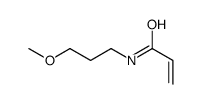N-(3-Methoxypropyl)acrylamide

N-(3-Methoxypropyl)acrylamide structure
|
Common Name | N-(3-Methoxypropyl)acrylamide | ||
|---|---|---|---|---|
| CAS Number | 107374-86-7 | Molecular Weight | 143.18400 | |
| Density | N/A | Boiling Point | N/A | |
| Molecular Formula | C7H13NO2 | Melting Point | N/A | |
| MSDS | Chinese USA | Flash Point | >230 °F | |
| Symbol |

GHS07 |
Signal Word | Warning | |
|
Sodium fluoride promotes apoptosis by generation of reactive oxygen species in human lymphocytes.
J. Toxicol. Environ. Health A 77(21) , 1269-80, (2014) Fluoride generated the attention of toxicologists due to its deleterious effects at high concentrations in human populations suffering from fluorosis and with in vivo experimental models. Interest in its undesirable effects has resurfaced due to the awareness... |
|
|
Methamidophos alters sperm function and DNA at different stages of spermatogenesis in mice.
Toxicol. Appl. Pharmacol. 279(3) , 391-400, (2014) Methamidophos (MET) is a highly toxic organophosphate (OP) pesticide that is widely used in developing countries. MET has male reproductive effects, including decreased fertility. We evaluated MET effects on sperm quality, fertilization and DNA integrity, exp... |
|
|
Melatonin Attenuates Oxidative Damage Induced by Acrylamide In Vitro and In Vivo.
Oxid. Med. Cell. Longev. 2015 , 703709, (2015) Acrylamide (ACR) has been classified as a neurotoxic agent in animals and humans. Melatonin (MT) has been shown to be potentially effective in preventing oxidative stress related neurodegenerative disorders. In this study, whether MT exerted a protective effe... |
|
|
In Vitro Safety/Protection Assessment of Resveratrol and Pterostilbene in a Human Hepatoma Cell Line (HepG2).
Nat. Prod. Commun. 10 , 1403-8, (2015) The aim of this work was to evaluate in vitro the genotoxic and/or antigenotoxic effects of resveratrol (RESV) and pterostilbene (PTER) on HepG2 cells. Moreover, additional tests were performed to evaluate early and late apoptosis events induced by the tested... |
|
|
Genotoxicity of drinking water disinfection by-products (bromoform and chloroform) by using both Allium anaphase-telophase and comet tests.
Cytotechnology 67(2) , 207-13, (2015) Genotoxic effects of bromoform and chloroform, disinfection by-products of the chlorination of drinking water, were examined by using mitotic index (MI), mitotic phase, chromosome aberrations (CAs) and comet assay on root meristematic cells of Allium cepa. Di... |
|
|
Evaluation of the Genotoxic and Physiological Effects of Decabromodiphenyl Ether (BDE-209) and Dechlorane Plus (DP) Flame Retardants in Marine Mussels (Mytilus galloprovincialis).
Environ. Sci. Technol. 50 , 2700-8, (2016) Dechlorane Plus (DP) is a proposed alternative to the legacy flame retardant decabromodiphenyl ether (BDE-209), a major component of Deca-BDE formulations. In contrast to BDE-209, toxicity data for DP are scarce and often focused on mice. Validated dietary in... |
|
|
Protective effects of extracts from Fructus rhodomyrti against oxidative DNA damage in vitro and in vivo.
Oxid. Med. Cell. Longev. 2013 , 507407, (2013) To evaluate the potential protective effects of extracts from Fructus rhodomyrti (FR) against oxidative DNA damage using a cellular system and the antioxidant ability on potassium bromate- (KBrO3-) mediated oxidative stress in rats.The effects of FR on DNA da... |
|
|
Determination of DNA damage in floriculturists exposed to mixtures of pesticides.
J. Biomed. Biotechnol. 2006 , 97896, (2006) The aim of the study was to determine possible DNA damage in floriculturists chronically exposed to pesticides. Leukocytes from 52 workers, 46 environmentally exposed, and 38 control individuals were evaluated with the comet assay. Serum from all individuals ... |
|
|
Pooled genome-wide analysis to identify novel risk loci for pediatric allergic asthma.
PLoS ONE 6 , e16912, (2011) Genome-wide association studies of pooled DNA samples were shown to be a valuable tool to identify candidate SNPs associated to a phenotype. No such study was up to now applied to childhood allergic asthma, even if the very high complexity of asthma genetics ... |
|
|
Genotoxic properties of representatives of alkylindazoles and aminoalkyl-indoles which are consumed as synthetic cannabinoids.
Food Chem. Toxicol. 80 , 130-6, (2015) Synthetic cannabinoids (SCs) cause similar effects as cannabis and are sold in herbal mixtures. Recent investigations indicate that some of these drugs possess genotoxic properties. Therefore, we tested representatives of two groups, namely, aminoalkylindoles... |